Page 17 of 90
JUMP STARTING YOUR VEHICLE
The 6.7 diesel engine can be jump started using the same procedure as a
gasoline engine. Use the primary battery (battery located on the
passenger side) for any jump starting procedure and refer to your
Owner’s Guidefor the proper method of jump starting.
RUNNING OUT OF DEF (DIESEL EXHAUST FLUID)
If your vehicle runs out of DEF, it will enter into a speed limited mode
and can also enter into an idle-only mode. Normal vehicle operation will
not resume until DEF is refilled. See theSelective Catalytic Reduction
(SCR) Systemsection in theMaintenance and Specificationschapter
for more information.
Contact roadside assistance for help in finding a retailer that sells DEF.
See theCustomer Assistancechapter in theOwner’s Guidefor more
information.
Roadside Emergencies
17
2011 Econoline(eco)
Supplement, 1st Printing
USA(fus)
Page 18 of 90
ENGINE
Engines are more efficient when they are clean because grease and dirt
buildup keep the engine warmer than normal. When washing:
•Take care when using a power washer to clean the engine. The
high-pressure fluid could penetrate the sealed parts and cause
damage.
•Do not spray a hot engine with cold water to avoid cracking the
engine block or other engine components.
•Spray Motorcraft�Engine Shampoo and Degreaser (ZC-20) on all
parts that require cleaning and pressure rinse clean.
•Never wash or rinse the engine while it is running; water in the
running engine may cause internal damage.
•Cover the highlighted areas to prevent water damage when cleaning
the engine.
Cleaning
18
2011 Econoline(eco)
Supplement, 1st Printing
USA(fus)
Page 19 of 90
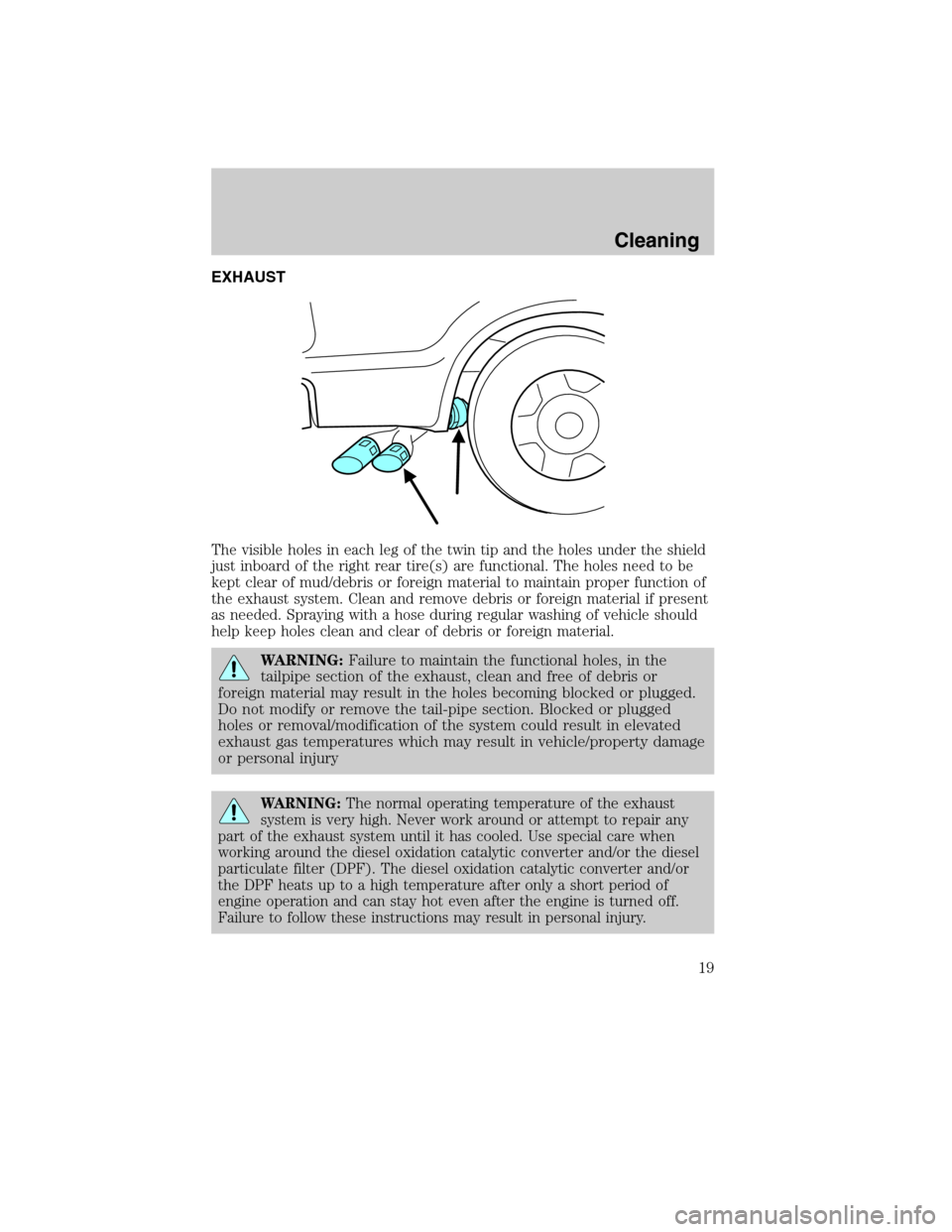
EXHAUST
The visible holes in each leg of the twin tip and the holes under the shield
just inboard of the right rear tire(s) are functional. The holes need to be
kept clear of mud/debris or foreign material to maintain proper function of
the exhaust system. Clean and remove debris or foreign material if present
as needed. Spraying with a hose during regular washing of vehicle should
help keep holes clean and clear of debris or foreign material.
WARNING:Failure to maintain the functional holes, in the
tailpipe section of the exhaust, clean and free of debris or
foreign material may result in the holes becoming blocked or plugged.
Do not modify or remove the tail-pipe section. Blocked or plugged
holes or removal/modification of the system could result in elevated
exhaust gas temperatures which may result in vehicle/property damage
or personal injury
WARNING:The normal operating temperature of the exhaust
system is very high. Never work around or attempt to repair any
part of the exhaust system until it has cooled. Use special care when
working around the diesel oxidation catalytic converter and/or the diesel
particulate filter (DPF). The diesel oxidation catalytic converter and/or
the DPF heats up to a high temperature after only a short period of
engine operation and can stay hot even after the engine is turned off.
Failure to follow these instructions may result in personal injury.
Cleaning
19
2011 Econoline(eco)
Supplement, 1st Printing
USA(fus)
Page 20 of 90
IDENTIFYING COMPONENTS IN THE ENGINE COMPARTMENT
F-Super Duty
1. Engine oil dipstick
2. Automatic transmission dipstick
3. Brake fluid reservoir
4. Power distribution box
5. Batteries
6. Engine cooling system coolant reservoir (primary high-temperature
cooling system)
7. Power steering fluid reservoir
8. Engine oil fill
9. Engine-mounted fuel filter assembly
10. Secondary cooling system coolant reservoir
11. Air filter assembly
12. Air filter restriction gauge
13. Windshield washer fluid reservoir
1135234
57691012118
Maintenance and Specifications
20
2011 Econoline(eco)
Supplement, 1st Printing
USA(fus)
Page 21 of 90
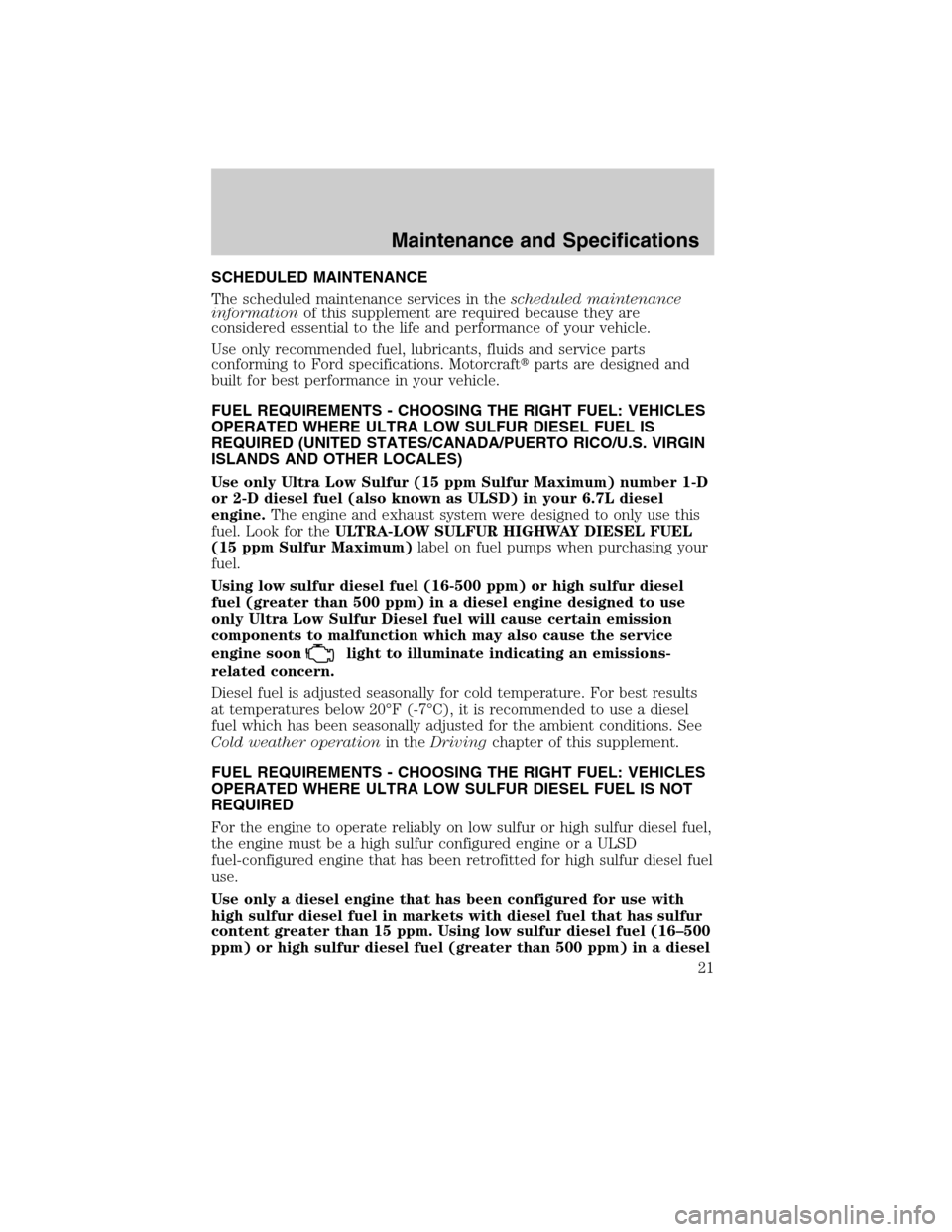
SCHEDULED MAINTENANCE
The scheduled maintenance services in thescheduled maintenance
informationof this supplement are required because they are
considered essential to the life and performance of your vehicle.
Use only recommended fuel, lubricants, fluids and service parts
conforming to Ford specifications. Motorcraft�parts are designed and
built for best performance in your vehicle.
FUEL REQUIREMENTS - CHOOSING THE RIGHT FUEL: VEHICLES
OPERATED WHERE ULTRA LOW SULFUR DIESEL FUEL IS
REQUIRED (UNITED STATES/CANADA/PUERTO RICO/U.S. VIRGIN
ISLANDS AND OTHER LOCALES)
Use only Ultra Low Sulfur (15 ppm Sulfur Maximum) number 1-D
or 2-D diesel fuel (also known as ULSD) in your 6.7L diesel
engine.The engine and exhaust system were designed to only use this
fuel. Look for theULTRA-LOW SULFUR HIGHWAY DIESEL FUEL
(15 ppm Sulfur Maximum)label on fuel pumps when purchasing your
fuel.
Using low sulfur diesel fuel (16-500 ppm) or high sulfur diesel
fuel (greater than 500 ppm) in a diesel engine designed to use
only Ultra Low Sulfur Diesel fuel will cause certain emission
components to malfunction which may also cause the service
engine soon
light to illuminate indicating an emissions-
related concern.
Diesel fuel is adjusted seasonally for cold temperature. For best results
at temperatures below 20°F (-7°C), it is recommended to use a diesel
fuel which has been seasonally adjusted for the ambient conditions. See
Cold weather operationin theDrivingchapter of this supplement.
FUEL REQUIREMENTS - CHOOSING THE RIGHT FUEL: VEHICLES
OPERATED WHERE ULTRA LOW SULFUR DIESEL FUEL IS NOT
REQUIRED
For the engine to operate reliably on low sulfur or high sulfur diesel fuel,
the engine must be a high sulfur configured engine or a ULSD
fuel-configured engine that has been retrofitted for high sulfur diesel fuel
use.
Use only a diesel engine that has been configured for use with
high sulfur diesel fuel in markets with diesel fuel that has sulfur
content greater than 15 ppm. Using low sulfur diesel fuel (16–500
ppm) or high sulfur diesel fuel (greater than 500 ppm) in a diesel
Maintenance and Specifications
21
2011 Econoline(eco)
Supplement, 1st Printing
USA(fus)
Page 22 of 90
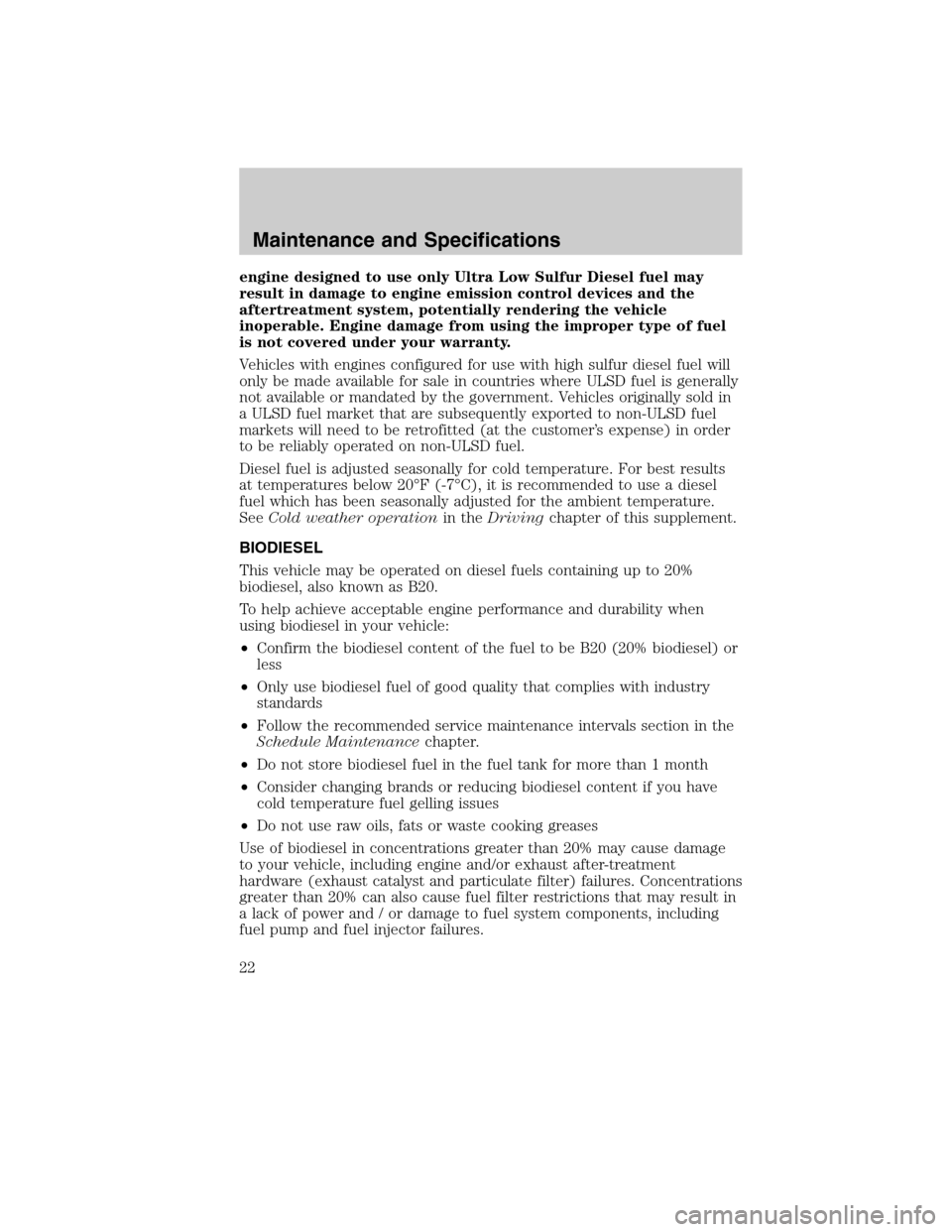
engine designed to use only Ultra Low Sulfur Diesel fuel may
result in damage to engine emission control devices and the
aftertreatment system, potentially rendering the vehicle
inoperable. Engine damage from using the improper type of fuel
is not covered under your warranty.
Vehicles with engines configured for use with high sulfur diesel fuel will
only be made available for sale in countries where ULSD fuel is generally
not available or mandated by the government. Vehicles originally sold in
a ULSD fuel market that are subsequently exported to non-ULSD fuel
markets will need to be retrofitted (at the customer’s expense) in order
to be reliably operated on non-ULSD fuel.
Diesel fuel is adjusted seasonally for cold temperature. For best results
at temperatures below 20°F (-7°C), it is recommended to use a diesel
fuel which has been seasonally adjusted for the ambient temperature.
SeeCold weather operationin theDrivingchapter of this supplement.
BIODIESEL
This vehicle may be operated on diesel fuels containing up to 20%
biodiesel, also known as B20.
To help achieve acceptable engine performance and durability when
using biodiesel in your vehicle:
•Confirm the biodiesel content of the fuel to be B20 (20% biodiesel) or
less
•Only use biodiesel fuel of good quality that complies with industry
standards
•Follow the recommended service maintenance intervals section in the
Schedule Maintenancechapter.
•Do not store biodiesel fuel in the fuel tank for more than 1 month
•Consider changing brands or reducing biodiesel content if you have
cold temperature fuel gelling issues
•Do not use raw oils, fats or waste cooking greases
Use of biodiesel in concentrations greater than 20% may cause damage
to your vehicle, including engine and/or exhaust after-treatment
hardware (exhaust catalyst and particulate filter) failures. Concentrations
greater than 20% can also cause fuel filter restrictions that may result in
a lack of power and / or damage to fuel system components, including
fuel pump and fuel injector failures.
Maintenance and Specifications
22
2011 Econoline(eco)
Supplement, 1st Printing
USA(fus)
Page 23 of 90
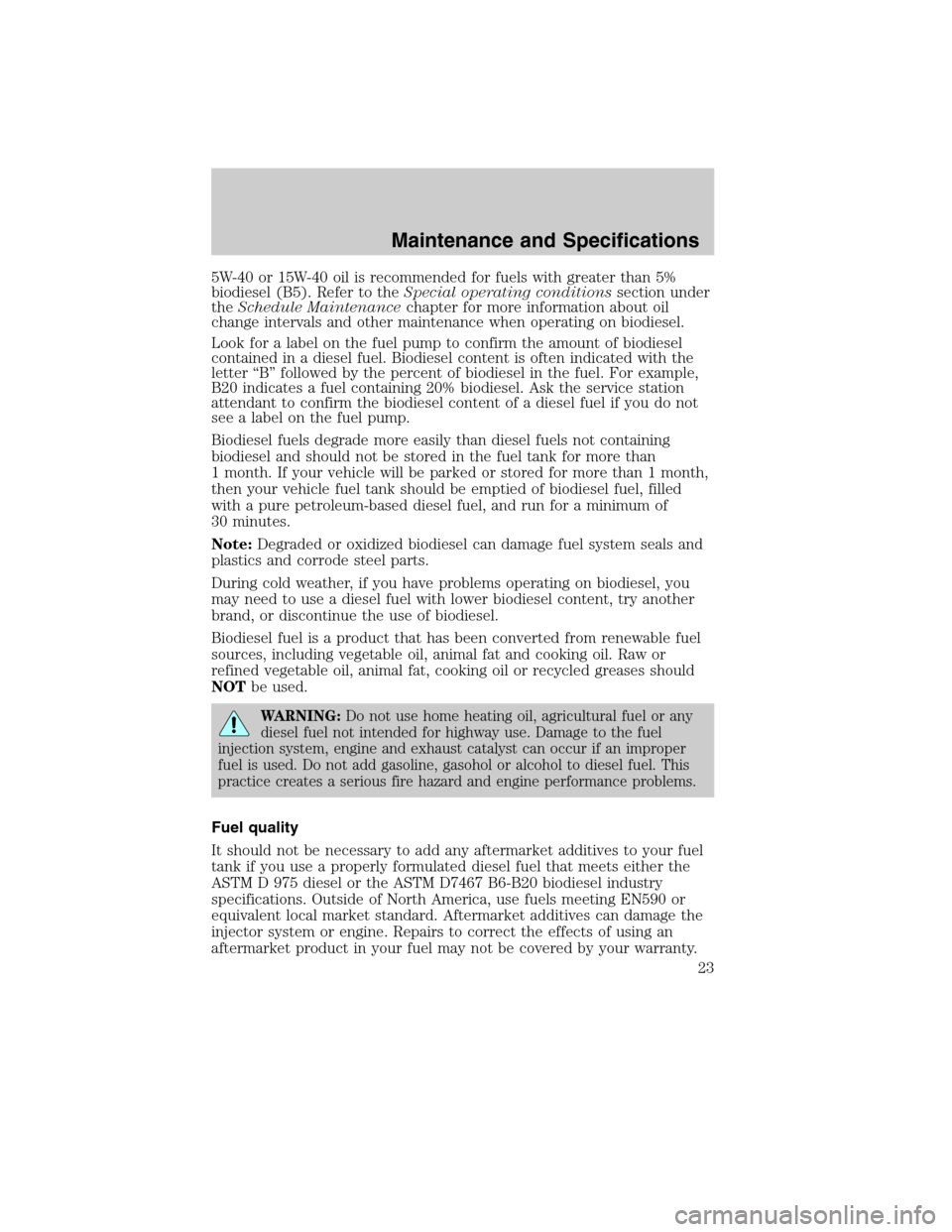
5W-40 or 15W-40 oil is recommended for fuels with greater than 5%
biodiesel (B5). Refer to theSpecial operating conditionssection under
theSchedule Maintenancechapter for more information about oil
change intervals and other maintenance when operating on biodiesel.
Look for a label on the fuel pump to confirm the amount of biodiesel
contained in a diesel fuel. Biodiesel content is often indicated with the
letter “B” followed by the percent of biodiesel in the fuel. For example,
B20 indicates a fuel containing 20% biodiesel. Ask the service station
attendant to confirm the biodiesel content of a diesel fuel if you do not
see a label on the fuel pump.
Biodiesel fuels degrade more easily than diesel fuels not containing
biodiesel and should not be stored in the fuel tank for more than
1 month. If your vehicle will be parked or stored for more than 1 month,
then your vehicle fuel tank should be emptied of biodiesel fuel, filled
with a pure petroleum-based diesel fuel, and run for a minimum of
30 minutes.
Note:Degraded or oxidized biodiesel can damage fuel system seals and
plastics and corrode steel parts.
During cold weather, if you have problems operating on biodiesel, you
may need to use a diesel fuel with lower biodiesel content, try another
brand, or discontinue the use of biodiesel.
Biodiesel fuel is a product that has been converted from renewable fuel
sources, including vegetable oil, animal fat and cooking oil. Raw or
refined vegetable oil, animal fat, cooking oil or recycled greases should
NOTbe used.
WARNING:Do not use home heating oil, agricultural fuel or any
diesel fuel not intended for highway use. Damage to the fuel
injection system, engine and exhaust catalyst can occur if an improper
fuel is used. Do not add gasoline, gasohol or alcohol to diesel fuel. This
practice creates a serious fire hazard and engine performance problems.
Fuel quality
It should not be necessary to add any aftermarket additives to your fuel
tank if you use a properly formulated diesel fuel that meets either the
ASTM D 975 diesel or the ASTM D7467 B6-B20 biodiesel industry
specifications. Outside of North America, use fuels meeting EN590 or
equivalent local market standard. Aftermarket additives can damage the
injector system or engine. Repairs to correct the effects of using an
aftermarket product in your fuel may not be covered by your warranty.
Maintenance and Specifications
23
2011 Econoline(eco)
Supplement, 1st Printing
USA(fus)
Page 24 of 90
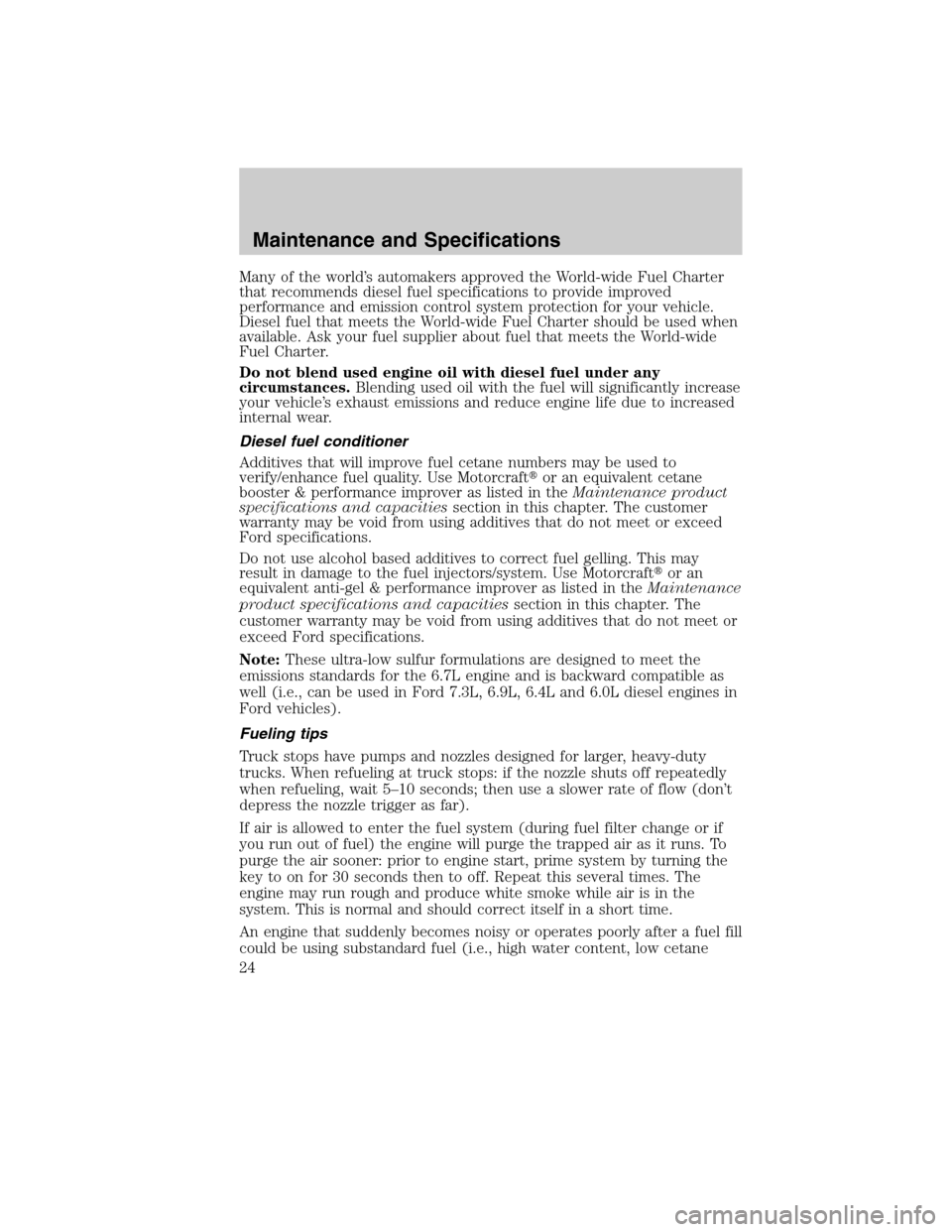
Many of the world’s automakers approved the World-wide Fuel Charter
that recommends diesel fuel specifications to provide improved
performance and emission control system protection for your vehicle.
Diesel fuel that meets the World-wide Fuel Charter should be used when
available. Ask your fuel supplier about fuel that meets the World-wide
Fuel Charter.
Do not blend used engine oil with diesel fuel under any
circumstances.Blending used oil with the fuel will significantly increase
your vehicle’s exhaust emissions and reduce engine life due to increased
internal wear.
Diesel fuel conditioner
Additives that will improve fuel cetane numbers may be used to
verify/enhance fuel quality. Use Motorcraft�or an equivalent cetane
booster & performance improver as listed in theMaintenance product
specifications and capacitiessection in this chapter. The customer
warranty may be void from using additives that do not meet or exceed
Ford specifications.
Do not use alcohol based additives to correct fuel gelling. This may
result in damage to the fuel injectors/system. Use Motorcraft�or an
equivalent anti-gel & performance improver as listed in theMaintenance
product specifications and capacitiessection in this chapter. The
customer warranty may be void from using additives that do not meet or
exceed Ford specifications.
Note:These ultra-low sulfur formulations are designed to meet the
emissions standards for the 6.7L engine and is backward compatible as
well (i.e., can be used in Ford 7.3L, 6.9L, 6.4L and 6.0L diesel engines in
Ford vehicles).
Fueling tips
Truck stops have pumps and nozzles designed for larger, heavy-duty
trucks. When refueling at truck stops: if the nozzle shuts off repeatedly
when refueling, wait 5–10 seconds; then use a slower rate of flow (don’t
depress the nozzle trigger as far).
If air is allowed to enter the fuel system (during fuel filter change or if
you run out of fuel) the engine will purge the trapped air as it runs. To
purge the air sooner: prior to engine start, prime system by turning the
key to on for 30 seconds then to off. Repeat this several times. The
engine may run rough and produce white smoke while air is in the
system. This is normal and should correct itself in a short time.
An engine that suddenly becomes noisy or operates poorly after a fuel fill
could be using substandard fuel (i.e., high water content, low cetane
Maintenance and Specifications
24
2011 Econoline(eco)
Supplement, 1st Printing
USA(fus)